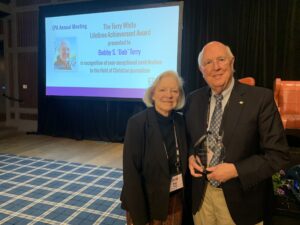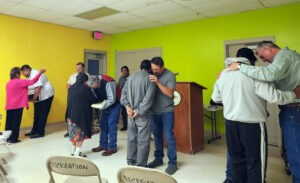
REVISED Friday, April 30, 2010
EDITOR’S NOTE: Bob Terry is editor of The Alabama Baptist (www.thealabamabaptist.org) of the Alabama Baptist State Convention. The article first appeared in The Alabama Baptist.
BIRMINGHAM, Ala. (BP)–Do you remember 2006? Southern Baptists were gathering in Greensboro, N.C., for their annual meeting. Johnny Hunt, pastor of First Baptist Church in Woodstock, Ga., had declined to be nominated for president of the Southern Baptist Convention (SBC). He promoted Ronnie Floyd, pastor of First Baptist Church in Springdale, Ark., for the office. But concern about the Cooperative Program (CP) giving of Floyd’s church, which was less than 1 percent of undesignated receipts at that time, caused widespread concern.
Some noted leaders of the conservative resurgence movement urged Jerry Sutton, then pastor of Two Rivers Baptist Church in Nashville, to enter the race. When the votes were counted, it was a third candidate — a relative newcomer to the SBC stage — who defeated both longtime SBC personalities on the first ballot. Frank Page, then pastor of First Baptist Church in Taylors, S.C., won largely because his church contributed 12.3 percent of undesignated receipts to support missions causes through the CP. SBC messengers sent a strong, unequivocal message — CP giving matters.
Now Southern Baptists are preparing for their 2010 annual meeting in Orlando, Fla. Only one candidate has been announced for SBC president so far [NOTE: This column was written before two other nominees for SBC president were announced], and he is campaigning on the fact that he led his church, Johnson Ferry Baptist Church in Marietta, Ga., to cut its giving to missions through the CP.
The news release announcing Bryant Wright’s candidacy outlined how he had led the church to lower CP giving from 10 percent to 5 percent and now 3.5 percent.
Wright wants 25 percent to 30 percent used for state causes with at least 50 percent going to the SBC’s International Mission Board (IMB). The Georgia Baptist Convention, which Wright’s church is affiliated with, says it divides CP funds 50–50 between state and SBC causes.
Johnson Ferry Baptist, with a resident membership of more than 7,000 and a worship attendance of more than 4,000, has redirected much of its missions money to direct projects with the IMB and will continue to do so, according to Wright.
It is amazing how the climate of Southern Baptist life has changed in four short years. In 2006, CP giving mattered. In 2010, the big thing is supporting the IMB.
Some voices claim the change occurred because Southern Baptists finally recognized that CP giving is about maintenance ministry while supporting the IMB is about penetrating lostness.
There are other possible scenarios that might help explain the change. In this column, we will address only one — the tension between megachurches and smaller churches.
For many, it is hard to imagine a local church with more staff members and resources than the Alabama Baptist State Board of Missions (SBOM). There are many, however. First Baptist Church in Woodstock, Ga., served by now SBC President Johnny Hunt, is but one.
While the SBOM budgeted nearly $14 million for state convention causes in 2010, First Woodstock, received nearly $17 million in undesignated gifts in 2009. The church has a marvelous ministry in its education program, music program, counseling center, recovery groups, pastoral care emphasis, missions efforts, technology support and more. And, of course, there is the great preaching and leadership Hunt provides. That is why multiple thousands worship there every week.
Megachurches like First Woodstock even support their own missionaries. They have resources to do things that average Baptist churches cannot do by themselves. Such churches do not need the cooperative efforts of sister churches to train teachers and leaders. They do not need joint missions projects. They do not need help from outside their own resources for evangelism efforts. God has blessed them to the point such churches can largely do what they want to do.
Now read the words of Mark Gallups, director of missions for Marion Baptist Association. He wrote, “My heart breaks for the pastor of Country Road Baptist Church, where there is no growth in the community. The baptism waters are seldom disturbed. Yet Country Road’s pastor is faithful day in and day out to proclaim the gospel, support CP giving, live on a pauper’s salary with no health insurance and literally sacrifice his life and family for the cause of Christ only to be ridiculed for not baptizing enough people.
“It is the average-size churches that give sacrificially, even to the point we don’t hire needed staff. We suffer and do without that the CP may be funded. We realize that together we can be more for Christ than we can be alone. We are not independent. We are 16 million strong,” he continued.
In the judgment of this writer, the desire to penetrate lostness is no greater in the megachurches that choose to support their own missionaries than it is in Country Road. The difference is that Country Road chooses a different methodology. Its way of penetrating lostness at home and around the world is by working with others in a commonly agreed on program.
To be sure, something Country Road might want included in the work cooperating churches choose to support might be left out. Something they might not favor may be included. But that does not cause Country Road to cease participation. By working with others, it can do more for God’s Kingdom than it could ever do alone.
Someone may observe that Country Road has no real choice. Its size and circumstances leave it only one effective methodology — cooperation. That may be true. When the CP was birthed in 1925, most SBC-related churches were more like Country Road than today’s megachurches.
Back then, it was the independent Baptist Bible Fellowship churches — the Baptist Temples of the nation’s major cities — and others who threw rocks at the methodology of cooperation and the CP. The biggest criticism was control. A church’s CP dollars might go to something it did not like or something that was not its priority.
But Southern Baptists stuck to their methodology of cooperation despite the criticism and supported missions at home and around the world through the CP. During the past 85 years, God has blessed the methodology of cooperation and the CP. Today it is still a good choice for Country Road and megachurches. In 2010, the CP still matters because Southern Baptists can still do more together than we can do apart.
–30–
This article originally appeared in The Alabama Baptist.















